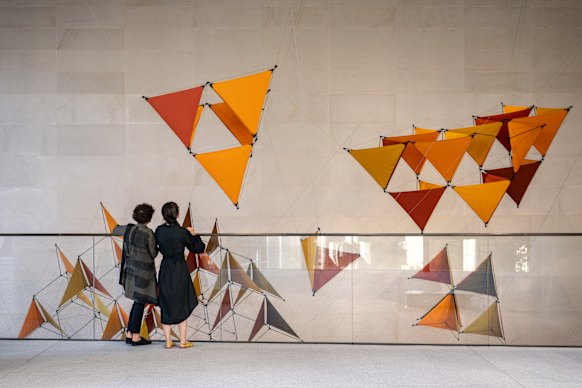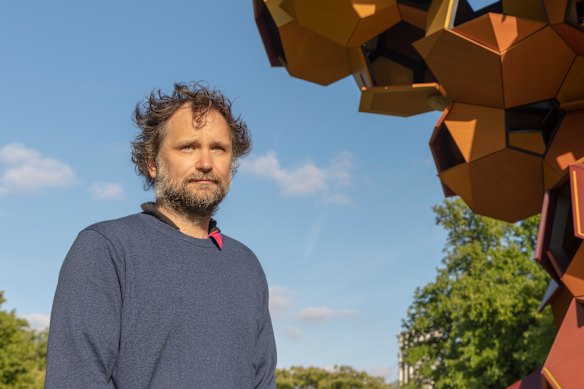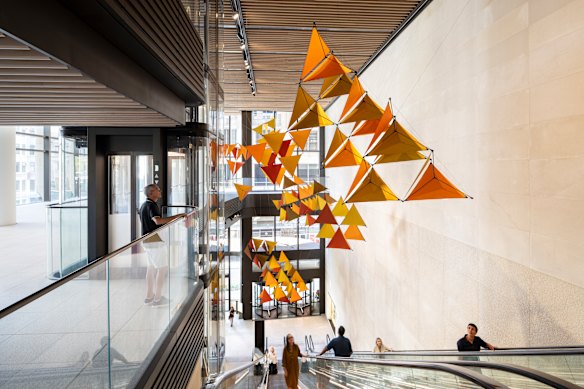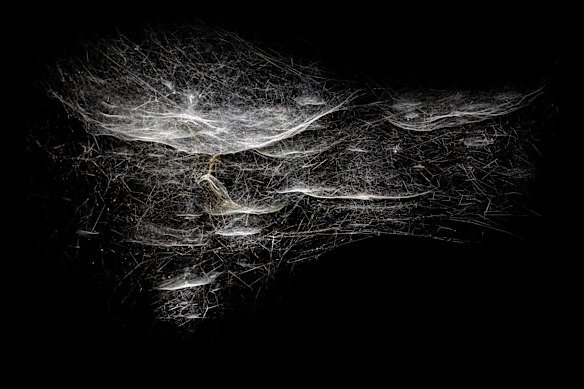By Julie Power
Most people think attic spaces are scary. Particularly when they hear something move that they can’t see, or walk into a spider’s web.
Not Tomás Saraceno, who has been called the artist most likely to change the world, the great Spider-Man of modern art, and a Renaissance mind for the 21st century. His first permanent public artwork in Australia has just opened in Sydney.

Tomás Saraceno’s The Seeds of Flight at Parkline Place above the Gadigal metro station in Sydney.Credit: Mark Pokorny
With his investigation of fossil fuel-free flight and fascination with airborne structures including clouds, spiderwebs, bubbles, kites and spores, the international artist could also be this generation’s Leonardo da Vinci.
“I always remember going up in the attic when nobody was living there, but actually, it was full of life because it was full of spiders, and spiderwebs,” Saraceno tells the Herald of his childhood home in Argentina.
“It seemed like nothing was living there, but there were spiders. And when the light came through the windows, it illuminated that spider.”
In a 2019 interview after a Berlin show, he said: “I always say that a spider looked down at me and told me, ‘You stupid human, do something’.”

Installation view at Tomás Saraceno in Collaboration: Web(s) of Life, Serpentine Gallery, London, 2023.Credit: Tomás Saraceno, World(Ing )Wide Web(S).Life, 2023
To him, a spider’s beauty was that it was always connected to its web, using vibrations to listen and connect with the world and other species. They are nature’s networkers.
Now 116 of Saraceno’s modular tetrahedrons, flying in squadrons of 15, seem to float midair in the triple-height lobby of Parkline Place on Pitt Street, above Gadigal metro station.
The finished artwork, The Seeds of Flight, is open to the public. Completed in the past few months, it reflects his fascination with alternative flight methods. It also captures the dream of floating free from fossil fuels, batteries, lithium, solar panels, helium and hydrogen, which is the goal of Aerocene, the non-profit foundation he initiated.
Inspired by Alexander Graham Bell’s tetrahedral kite experiments, these sculptures don’t just look like they can fly; earlier models have taken flight.

Tomás Saraceno’s first permanent work in Sydney can now be seen. It is unlikely to be his last piece for the city.Credit: Dario Lagana
The colours are those of the Australian bush, developed with Matt Poll, manager of Indigenous programs at the Australian Maritime Museum.
Saraceno said it was an “artwork that drifts along the rivers of the wind, suspended like stars and planets carrying constellations of life’s seeds through the universe … it attempts to remind us that we are all on board this Mother Earth”.
“Together with spores, spiders, birds, eucalyptus trees, can humans also float freely, without lithium or fossil fuels?
“In the interest of the trillions of inhabitants who would like to keep journeying around the sun, might we choose orbits of solidarity over extraction?”

Another view of The Seeds of Flight in Parkline Place, Sydney.Credit: Mark Pokorny
Connecting science with art, Saraceno has brought together musicians, scientists, aerospace engineers, ballooning experts, physicists, kite makers and Indigenous elders to reimagine and reinvent our relationship with the air and the earth.
Saraceno’s interest in spiders resulted in major installations at Tasmania’s MONA and Britain’s Tate Modern, where his installation Web(s) of Life received rave reviews.
As well as major exhibitions and installations, Saraceno has done an international space program at NASA’s Ames Centre, studied with the Centre National d’Études Spatiales, Paris, and continues to work with the MIT Centre for Art, Science and Technology in Cambridge.
Saraceno founded Arachnophilia, an interdisciplinary research community with MIT and the Max Planck Institute, and recorded the vibrations of spiderwebs. He then invited musicians to jam with the sounds, to unveil their hidden musicality.

Saraceno’s Webs of At-tent(s)ion, installation at MONA in 2022.Credit: Tomás Saraceno and MONA
He also created the Spider Web Scan – a laser-supported tomographic method – to study the architecture of their webs.
Aerocene has broken records for solar-powered flight. In January 2020, Aerocene Pacha, piloted by Leticia Noemi Marqués, set 32 records for solar-powered flights recognised by the Federation Aeronautique Internationale.
An interview with Saraceno is like being carried along a jet stream. Was he an artist or a scientist? “I am a little bit of everything,” he said.
Saraceno abhors the myth of the lone genius, detests Elon Musk’s Starlink with its reliance on fossil fuels, and says the only way to change the world is through collaboration.
Single disciplines cannot solve problems such as climate change, global warming and inequality. “So why don’t we try to weave or work together in different ways?”
Seeds of Flight, developed by Investa on behalf of Oxford Properties Group and Mitsubishi Estate Asia, took more than two years to design and produce following a 13-month selection process led by curator Barbara Flynn.
Flynn said they were looking for artists whose work was unlike anything the public would normally see.
“We chose [Tomas] for the way he brings people along by exciting them and giving them something important to do and be part of. We liked his optimism and could see how it pervades everything he makes and does.”
Will he change the world? Flynn said: “He’s trying, and that counts for a lot.”
Start the day with a summary of the day’s most important and interesting stories, analysis and insights. Sign up for our Morning Edition newsletter.